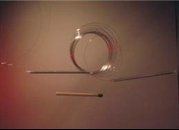Hollow-core fibre based microwave clock 
we use a hollow-core fibre filled with room-temperature Cs-vapour to sensitively  probe a microwave transition of the trapped sample. Techniques from magneto-optical-resonance spectroscopy (morse) are adapted and used to sensitively probe microwave resonances with an optical detection system. Using a clock transition of the trapped atom the microwave can be locked with very high-precision. The influence of van-der-Waals interactions between the atoms and the surface walls as well as collisional frequency shifts will be mapped out.
probe a microwave transition of the trapped sample. Techniques from magneto-optical-resonance spectroscopy (morse) are adapted and used to sensitively probe microwave resonances with an optical detection system. Using a clock transition of the trapped atom the microwave can be locked with very high-precision. The influence of van-der-Waals interactions between the atoms and the surface walls as well as collisional frequency shifts will be mapped out.